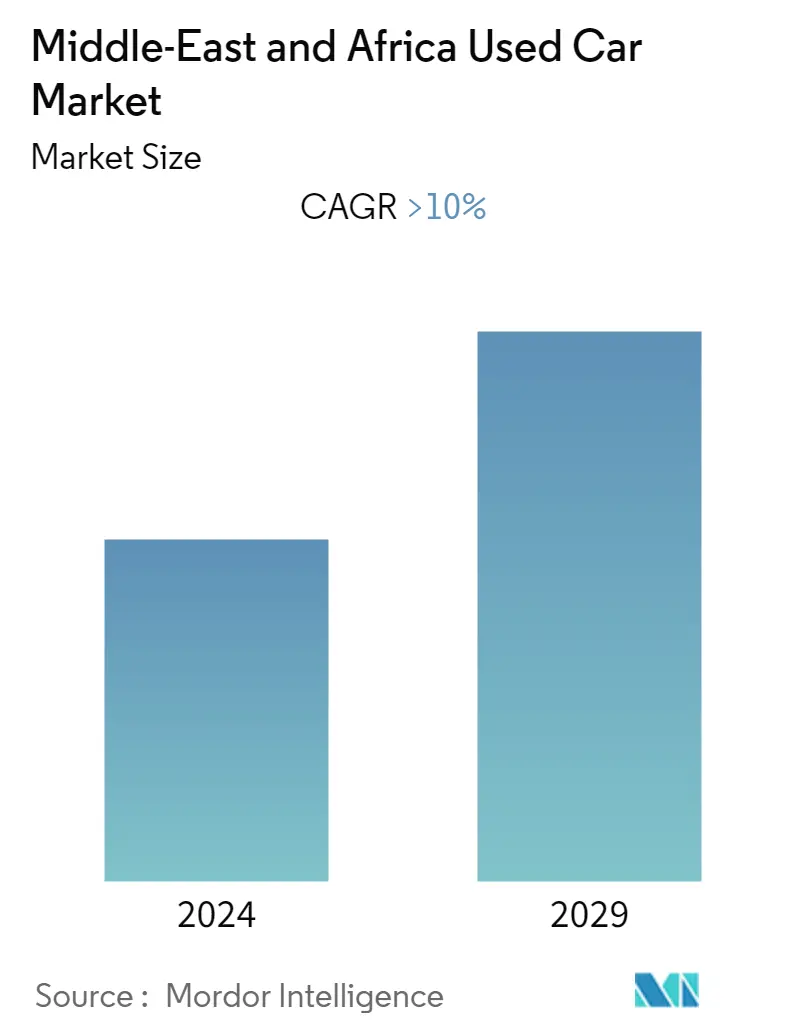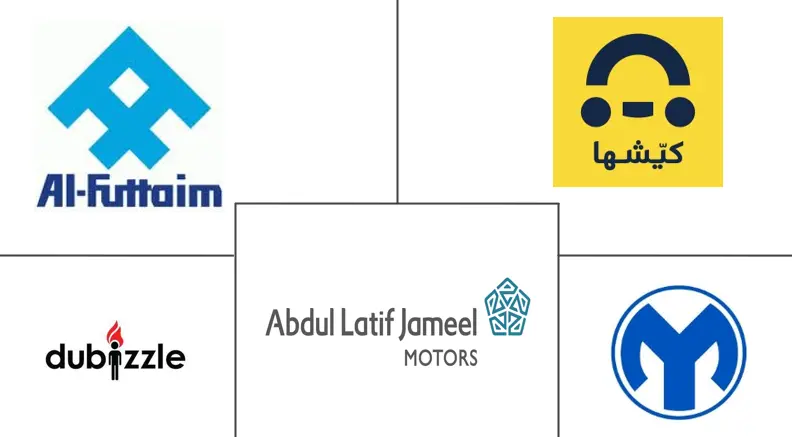Market Size of Middle-East and Africa Used Car Industry

| Study Period | 2019 - 2029 |
| Base Year For Estimation | 2023 |
| Forecast Data Period | 2024 - 2029 |
| Historical Data Period | 2019 - 2022 |
| CAGR | 10.00 % |
| Market Concentration | Medium |
Major Players
*Disclaimer: Major Players sorted in no particular order |
Middle East and Africa Used Car Market Analysis
The Middle-East and Africa Used Car Market was valued at USD 18.20 Billion in 2021 and is expected to reach USD 32.20 Billion by 2027, registering a CAGR of over 10.82% during the forecast period (2022 - 2027).
The emergence of the COVID-19 pandemic had a huge impact on the automotive sector in the Middle-East and Africa, causing supply chain disruption and transportation halts, as well as a lack of fresh additions to the used car fleet. This resulted in a decrease in the number of models available for purchase, as well as a decrease in the number of purchases. However, in the latter half of 2020, i.e., after Q3 and between Q1 2021, the market began to open up again, returning to pre-pandemic levels and expanding chances for the Middle-East and Africa used automobile industry.
By Q2 2021, Africa accounts for the largest import of used vehicles, around 40%, which is majorly driven by the countries like Nigeria and Libya, 85% of the total vehicle fleet in Africa is contributed by used vehicles. Due to high carbon emissions from the used vehicle and to protect the local vehicle manufacturing industry, several regional regulatory bodies have imposed a ban on the import of used vehicles.
The market for used cars in the Middle-East and Africa is continuously expanding. The introduction of organized participants into the market in developing countries has addressed the trust deficit that has plagued the used car industry in those countries for decades.
Additional factors driving market expansion include rising disposable income levels, rising consumer demand for luxury automobiles, shorter car ownership durations, expanding import-export, and a growing inclination among two-wheeler owners to upgrade to tiny and compact cars. Thus, the consumers in Middle-Eastern countries and the African region have witnessed a steep rise in their purchasing power, and with used car availability, now each and every income class in Middle-East and African region are capable of buying a car, making a prominent share in the market growth. However, the market is still in the growth phase and is projected to witness prominence during the forecast period 2022-2027.
Middle East and Africa Used Car Industry Segmentation
The Used Car Market is segmented by Vehicle Type (Hatchback, Sedan, and Sports Utility Vehicle(SUV)), Vendor Type (Organized and Unorganized), and By Country (United Arab Emirates, Saudi Arabia, Kenya, Egypt, and the Rest of Middle-East and Africa). The Report Offers Market Size and Forecast in Value (USD billion) for the above-mentioned Segments.
In addition, all the regulatory policies shaping the purchase of used electric vehicles in the Middle-East and African region have been portrayed in the report for a deep and comprehensive understanding of market dynamics.
Middle-East and Africa Used Car Market Size Summary
The Middle East and Africa used car market is experiencing significant growth, driven by various factors such as rising disposable incomes, increased consumer demand for luxury vehicles, and a shift in consumer preferences towards compact cars. The market, which faced challenges due to the COVID-19 pandemic, has rebounded and is expanding, with organized participants addressing trust issues that have historically plagued the industry. The availability of used cars has made it possible for consumers across different income levels to purchase vehicles, contributing to the market's expansion. Despite the dominance of unorganized players, the market is gradually moving towards consolidation, with organized and semi-organized sectors expected to generate more revenue in the coming years.
The United Arab Emirates stands out as a key growth enabler in the region, with a robust consumer base for used cars and a well-developed network of used car sellers. The UAE's unique market dynamics, such as the rapid depreciation of car values and the Secure Diagnostic Test, enhance consumer trust in used car purchases. The market is characterized by a fragmented landscape, with major players benefiting from superior business models and extensive retail outlets. Initiatives like the digital car marketplace launched by Abu Dhabi Islamic Bank are further streamlining the buying process, making it easier for consumers to access a wide range of vehicles and services. As the market continues to evolve, countries like Iran, Kuwait, and Turkey are also contributing to the region's growth trajectory.
Middle-East and Africa Used Car Market Size - Table of Contents
-
1. MARKET DYNAMICS
-
1.1 Market Drivers
-
1.2 Market Restraints
-
1.3 Porter's Five Forces Analysis
-
1.3.1 Threat of New Entrants
-
1.3.2 Bargaining Power of Buyers/Consumers
-
1.3.3 Bargaining Power of Suppliers
-
1.3.4 Threat of Substitute Products
-
1.3.5 Intensity of Competitive Rivalry
-
-
-
2. MARKET SEGMENTATION
-
2.1 Vehicle Type
-
2.1.1 Hachbacks
-
2.1.2 Sedan
-
2.1.3 Sports Utility vehicles (SUV)
-
-
2.2 Vendor Type
-
2.2.1 Organized
-
2.2.2 Unorganized
-
-
2.3 Country
-
2.3.1 United Arab Emirates
-
2.3.2 Saudi Arabia
-
2.3.3 Egypt
-
2.3.4 Kenya
-
2.3.5 Rest of Middle-East and Africa
-
-
Middle-East and Africa Used Car Market Size FAQs
What is the current Middle-East and Africa Used Car Market size?
The Middle-East and Africa Used Car Market is projected to register a CAGR of greater than 10% during the forecast period (2024-2029)
Who are the key players in Middle-East and Africa Used Car Market?
Al-Futtaim Group, Dubizzle Motors LLC, Kayishha, Abdul Latif Jameel Motors and Yallamotor are the major companies operating in the Middle-East and Africa Used Car Market.

